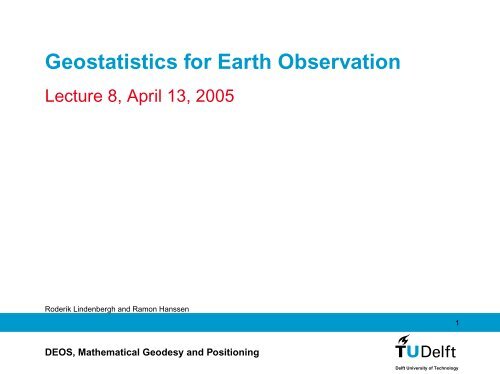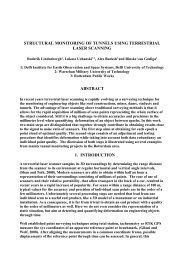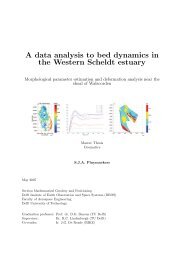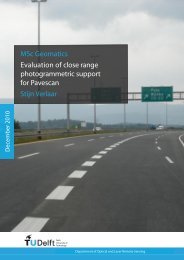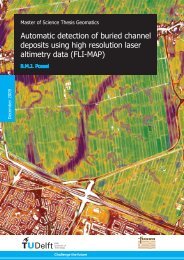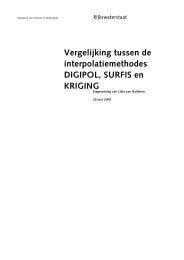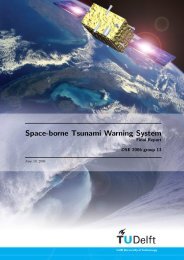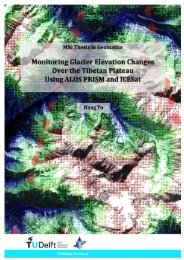DEOS, Mathematical Geodesy and Positioning
DEOS, Mathematical Geodesy and Positioning
DEOS, Mathematical Geodesy and Positioning
- No tags were found...
Create successful ePaper yourself
Turn your PDF publications into a flip-book with our unique Google optimized e-Paper software.
Geostatistics for Earth ObservationLecture 8, April 13, 2005Roderik Lindenbergh <strong>and</strong> Ramon Hanssen1<strong>DEOS</strong>, <strong>Mathematical</strong> <strong>Geodesy</strong> <strong>and</strong> <strong>Positioning</strong>Delft University of Technology
OverviewH<strong>and</strong>ling spatial components. .• Short remark on anisotropy.• Spatial components.• Signal <strong>and</strong> covariance decomposition.• Range of influence.• Filter method.• Filter example.2<strong>DEOS</strong>, <strong>Mathematical</strong> <strong>Geodesy</strong> <strong>and</strong> <strong>Positioning</strong>
Anisotropy revisited.Let h = (x 1 , y 1 ) − (x 2 , y 2 ), that is, h ∈ IR 2 .1D method.• Determine geometric transformation A : IR 2 → IR 2 that convertsiso-variability ellipses into circles.• Use a 1D variogram on the transformed difference vectors, that is considerh→√h∗ · A · h → γ 1D ( √ h ∗ · A · h)2D method.“• Determine a base B = (iso-variability ellipses.uxuy” “,• Express h with respect to B, resulting in h ′ .vxvy”) for the principal axes of the• Use a 2D variogram γ 2D on h ′ = (h ′ x, h ′ y), so considerh → h ′ = B −1 · h → γ 2D (h ′ )3<strong>DEOS</strong>, <strong>Mathematical</strong> <strong>Geodesy</strong> <strong>and</strong> <strong>Positioning</strong>
Spatial components.Until now: one scale of spatialvariability modelled by onevariogram.But typically:Signal=Measurement inaccuracy+Short range signal+Long range signal4<strong>DEOS</strong>, <strong>Mathematical</strong> <strong>Geodesy</strong> <strong>and</strong> <strong>Positioning</strong>
Signal <strong>and</strong> covariance decomposition.Signal decomposition:Nested covariance model:H(p) = H 0 (p) + H 1 (p) + H 2 (p), p ∈ IR 2Cov(h) = Cov0(h) + Cov1(h) + Cov2(h),with ranges R 0 = 0 (nugget) <strong>and</strong> 0 < R 1 < R 2 .h ∈ IRWrite S = {p 1 , . . . , p n } for the observation locations.Consider the distance d(p 0 , S) between the estimation location p 0closest observation from S.<strong>and</strong> the5<strong>DEOS</strong>, <strong>Mathematical</strong> <strong>Geodesy</strong> <strong>and</strong> <strong>Positioning</strong>
Only far away observations: d(p 0 , S) > R 2 .Proximity vector vanishes:d n =0B@Cov 10.Cov n011 0CA = B@Cov0 10.Cov0 n011 0CA + B@Cov1 10.Cov1 n011 0CA + B@Cov2 10.Cov2 n011 0CA = B@0.011CA6<strong>DEOS</strong>, <strong>Mathematical</strong> <strong>Geodesy</strong> <strong>and</strong> <strong>Positioning</strong>
No close observations: R 1 < d(p 0 , S) < R 2 .Nugget <strong>and</strong> short range covariance vector have no influence in proximityvector:d n =0B@Cov 10.Cov n011 0CA = B@Cov0 10.Cov0 n011 0CA + B@Cov1 10.Cov1 n011 0CA + B@Cov2 10.Cov2 n011 0CA = B@Cov2 10.Cov2 n011CA7<strong>DEOS</strong>, <strong>Mathematical</strong> <strong>Geodesy</strong> <strong>and</strong> <strong>Positioning</strong>
Close observations: 0 < d(p 0 , S) < R 1 .Nugget has no influence in proximity vector:d n =0B@Cov 10..Cov n01 0CA = B@Cov0 10..Cov0 n01 0CA + B@Cov1 10..Cov1 n01 0CA + B@Cov2 10..Cov2 n01 0CA = B@Cov1 10..Cov1 n01 0CA + B@Cov2 10..Cov2 n01CA1111118<strong>DEOS</strong>, <strong>Mathematical</strong> <strong>Geodesy</strong> <strong>and</strong> <strong>Positioning</strong>
Coincidence with observation: d(p 0 , S) = 0.Ordinary Kriging just returns observation <strong>and</strong> ‘does not interpolate’.Apply this analysis to filter spatial components!<strong>DEOS</strong>, <strong>Mathematical</strong> <strong>Geodesy</strong> <strong>and</strong> <strong>Positioning</strong>9
FilteringWish list:• Avoid peaks at observation locations;• Smoothen short range variations;• Or, on the contrary, remove a long range trend.Method:• Filter one or more spatial components (like nugget effect, short or longrange variability) from the signal.• Combine results.How:• Omit the correponding covariance contribution(s) from the proximityvector.• Combine by e.g. subtracting the filtered interpolation from the OKinterpolation.10<strong>DEOS</strong>, <strong>Mathematical</strong> <strong>Geodesy</strong> <strong>and</strong> <strong>Positioning</strong>
Some filter results11<strong>DEOS</strong>, <strong>Mathematical</strong> <strong>Geodesy</strong> <strong>and</strong> <strong>Positioning</strong>


